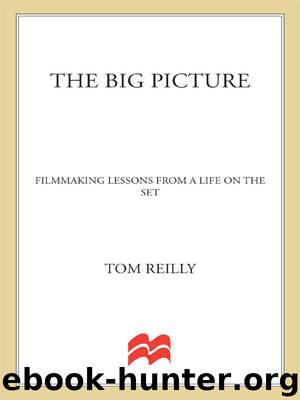The Big Picture by Tom Reilly

Author:Tom Reilly
Language: eng
Format: azw3
ISBN: 9780312380380
Publisher: St. Martin's Press
Published: 2009-05-12T04:00:00+00:00
28
THE ACTOR’S DON’T ALWAYS HAVE TO BE IN FRAME.
IN Bullets Over Broadway, there is a scene where the gangster hit man Cheech (Chazz Palminteri) takes a rival goon down to the docks and shoots and kills him. Later in the film, he does the same thing when he wants to get rid of his boss’s girlfriend, Olive (Jennifer Tilly). The car pulls up at night, we see the dock and the water, the victims step behind a barrier that blocks them from view, and then we see and hear a gunshot, followed by a splash. Cheech walks back to his car and drives away. The audience doesn’t see exactly what happened, but we aren’t left in the dark, either. It is perfectly clear that neither the rival goon nor Olive is still with us, even though we didn’t actually see them murdered. There were no stuntmen, no special effects makeup, no bullet hits, no squibs. It was a literal and a metaphorical “clean hit.” The mission was accomplished in terms of delivering the story point in a streamlined, inexpensive, and relatively simple shot. Fundamentally, the scene was blocked in an effective and efficient way.
But the scene was not staged this way for simplicity’s sake. Bullets Over Broadway, although a period gangster film, is, first and foremost, a comedy, which required that the violence be handled in a stylized, almost comic book manner. As a result, the shot design for these “hits” enabled the scene to sustain the comedie undertones necessary for the film, precisely because they were so bloodless and the real violence occurred off-camera. Clearly, when shooting a film, the actors don’t always have to be in frame and the action of a scene can occur offscreen, as well. It is a device that Woody uses quite effectively for all sorts of creative reasons, and not just to soften and take the edge off of a violent scene imbedded in a comedy.
In an early scene in Interiors, Mike (Sam Waterston) is sitting at the kitchen table in his apartment, dictating into a tape recorder, when the door buzzer sounds. Obviously annoyed by the interruption, he gets up and leaves the room to answer the door. As he does so, he walks out of frame as the camera stays on a wide shot of the room. We overhear his conversation with Eve (Geraldine Page) at the door but stay with the tied-off camera shot of the apartment. There is no coverage, the camera doesn’t move, and for part of the scene the actors are completely out of frame (twenty-two seconds). The overall effect this has is to focus our interest on the dialogue. We have no visual distractions, and by blocking the scene in this manner, Woody directs the film viewer’s attention in a concentrated way to the words being spoken.
In Stardust Memories, there is a visually striking scene in the hotel room at the beachside resort where Sandy Bates (Woody Allen) is attending an event. Although we can’t see
Download
This site does not store any files on its server. We only index and link to content provided by other sites. Please contact the content providers to delete copyright contents if any and email us, we'll remove relevant links or contents immediately.
The Kite Runner by Khaled Hosseini(5133)
Gerald's Game by Stephen King(4607)
Dialogue by Robert McKee(4353)
The Perils of Being Moderately Famous by Soha Ali Khan(4194)
The 101 Dalmatians by Dodie Smith(3481)
Story: Substance, Structure, Style and the Principles of Screenwriting by Robert McKee(3419)
The Pixar Touch by David A. Price(3389)
Confessions of a Video Vixen by Karrine Steffans(3273)
How Music Works by David Byrne(3233)
Harry Potter 4 - Harry Potter and The Goblet of Fire by J.K.Rowling(3031)
Fantastic Beasts: The Crimes of Grindelwald by J. K. Rowling(3029)
Slugfest by Reed Tucker(2972)
The Mental Game of Writing: How to Overcome Obstacles, Stay Creative and Productive, and Free Your Mind for Success by James Scott Bell(2876)
4 - Harry Potter and the Goblet of Fire by J.K. Rowling(2683)
Screenplay: The Foundations of Screenwriting by Syd Field(2601)
The Complete H. P. Lovecraft Reader by H.P. Lovecraft(2528)
Scandals of Classic Hollywood: Sex, Deviance, and Drama from the Golden Age of American Cinema by Anne Helen Petersen(2491)
Wildflower by Drew Barrymore(2466)
Robin by Dave Itzkoff(2411)
